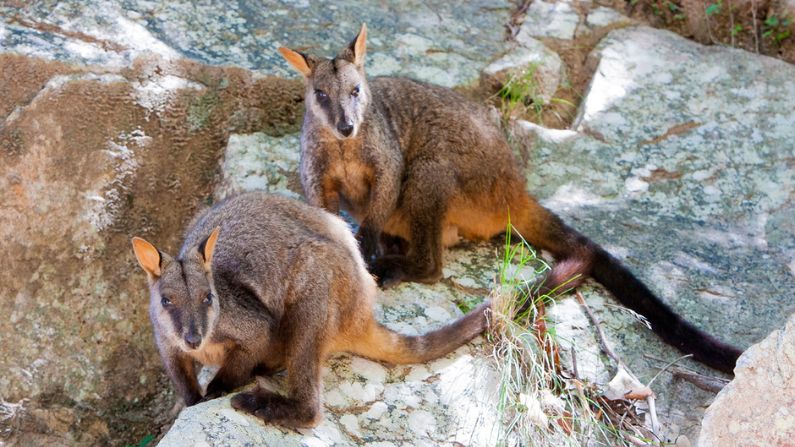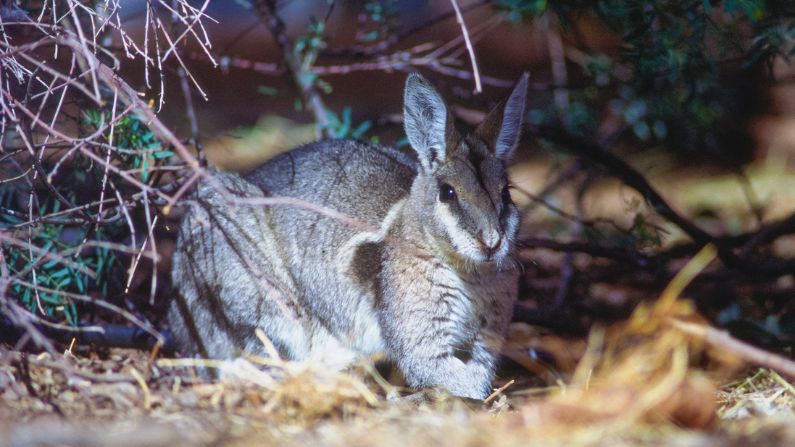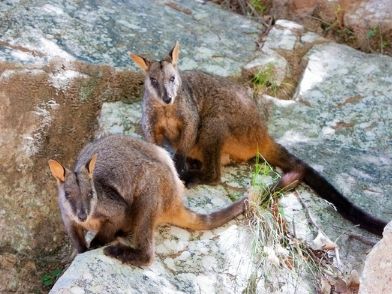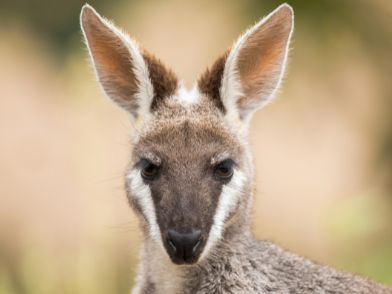Bridled nailtail
wallaby
© Bruce Thomson
The bridled nailtail wallaby (Onychogalea fraenata) is one of three nailtail wallaby species, only two of which exist today. All these species of wallaby are named after the bony nail-like projection at the end of the tail. The northern nailtail wallaby (O. unguifera) remains secure in northern Queensland and the Northern Territory. The crescent nailtail wallaby (O. lunata) was declared extinct in 1956 as a result of fox and cat predation and land clearing.
Quick facts
Bridled nailtail wallaby
SCIENTIFIC NAME:
Onychogalea fraenata
FAMILY:
Macropodidae
RECOVERY PLAN:
Recovery plan for the Bridled nailtail wallaby (Onychogalea fraenata) 2005–2009
ALSO KNOWN AS:
Flashjack, Waistcoat wallaby, Pademelon (though it’s not really a Pademelon), Merrin (Indigenous)
QLD CONSERVATION STATUS:
Endangered
NATIONAL CONSERVATION STATUS:
Endangered
Conservation activities
- Project Kial, run by Australian Animals Care and Education Inc., maintains a captive breeding population at their facility.
- A fenced or “captive” population exists at Scotia Sanctuary near Broken Hill, New South Wales.
- Wildlife Queensland partnered with the Queensland Parks and Wildlife Service at Taunton National Park (Scientific) in 1992 to enhance the management of the national park and conservation of the endangered bridled nailtail wallaby. The voluntary assistance provided by Wildlife Queensland through its Friends of Taunton group enhanced the capacity of the Service to undertake management activities pertaining to the conservation of the bridled nailtail wallaby and its habitat.
 © Bruce Thomson
© Bruce Thomson
Did you know?
Prior to the arrival of Europeans, the bridled nailtail wallaby’s distribution extended from Charters Towers through central Queensland down through New South Wales, west to Cobar and into northern Victoria. Early European explorers and naturalists reported them to be relatively common. On some expeditions, they were the most frequently observed wallaby. Yet by 1929 they had all but vanished. With no confirmed sightings for over 35 years, the bridled nailtail wallaby was presumed extinct. In 1973 a small bridled nailtail wallaby colony was discovered on a Central Queensland grazing property near Dingo.
 © Bruce Thomson
© Bruce Thomson
Threats to the bridled nailtail wallaby
- Habitat loss and modification
- land clearing
- weeds
- introduced pasture grasses e.g. buffelgrass
- altered fire regimes impacting on fire-sensitive habitat and fodder plants.
- weeds
- Predation
- wild dogs
- cats
- foxes
- cats
- Competition with introduced herbivores
- Rabbits
- land clearing
Home range
- Males ~ 66 hectares.
- Females ~ 23 hectares.
Distribution
- The only known naturally wild population occurs at Taunton National Park (Scientific) near Dingo, west of Rockhampton.
- Small wild populations have been established at Avocet Nature Refuge near Springsure, and Idalia National Park, south of Longreach.
It is estimated that in the wild fewer than 500 bridled nailtail wallabies exist across three populations.
Description
- Described by Gould as ‘One of the most beautiful and graceful objects that can be conceived’.
- Small to medium-sized wallaby.
- Adult males 5–8 kg.
- Adult females 4–5 kg.
- Head to tail length can reach slightly longer than 1 m. The tail makes up half of the total length.
- Grey, white and yellowish fur.
- Named “bridled” for the distinctive dark-bordered white stripes that run from the cheeks, down the back of the neck and around behind the shoulders.
- Has a small, claw-like spur or “nail” 3–6 mm long and is partly covered in the hair at the end of its tail.
- When racing away at high speeds, rotates forearms – hence the nickname ‘organ grinder’.
Nailtail function
The purpose of the spur or “nail” at the end of the tail is unknown. It possibly helps the animal keep stable or change direction when travelling at high speeds.
Habitat
The bridled nailtail wallaby occupies edge habitats between dense acacia shrubland and open grassy eucalypt woodland.
At Taunton National Park (Scientific) it uses:
- Open grassy eucalypt woodland dominated by poplar box (Eucalyptus populnea).
- Dense acacia forest dominated by brigalow (Acacia harpophylla).
- Transitional vegetation between the woodland and forest.
- Dense brigalow regrowth.
Any undiscovered wild populations would probably occur in mature or regenerating brigalow scrub.
Ecology
Life history and behaviour
- 10–12 years in captivity.
- 6–8 years in the wild.
- Wallaby mothers build nests in long grass, stick piles and hollow logs.
- Primarily nocturnal, emerging a few hours before nightfall to forage and groom.
- Daytime is spent resting and sheltering predominantly on the edges of brigalow scrubs under bushes, stick piles, logs and long grass or inside hollow logs. They may scratch a shallow depression of bare ground or “scrape” under or beside a shelter site. Except in drier months, the bridled nailtail wallaby rarely ventures more than 200m away from the edge of the scrub.
- Very acute hearing alerts it to anything approaching from a distance
- They are quite “shy” animals that freeze when disturbed. They may seek protection in a hollow log, under a bush or even lie flat in long grass.
- If it detects that it has been spotted by a nearby predator, the bridled nailtail wallaby will bolt at high speed. The ability to flee at high speed may have earned their name “flashjack”. Though the main defence strategy of the BNTW is to hide rather than flee.
- Usually solitary but females may have young at foot. Groups can occur in common feeding areas.
- Males congregate around a female in oestrous.
Breeding
- Females breed continuously and when conditions are suitable can raise up to 3 young in a year.
- Gestation period is about 23-24 days and pouch life is about 4 months.
- Juvenile females become sexually mature and may breed within 1 to 2 months after permanent pouch emergence. Males take about 9 months to mature.
- Little is known about the population dynamics of the species though observations indicate that, even though it is solitary a lot of the time, it is a social animal with distinct hierarchies.
Food
The bridled nailtail wallaby has quite a diverse diet which includes herbs, forbs, grasses and some browse. During good seasons they select their preferred food plants, which are herbs and forbs, while they are available and switch to grasses during dryer seasons when herbs and forbs become scarce. During very dry periods they have been observed browsing directly on false sandalwood Eremophila mitchellii and also eating fallen leaves from that shrub.
Preferred food plants include:
- Chenopodiaceae
- Atriplex semibaccata Berry saltbush.
- Einadia nutans Climbing or Nodding saltbush.
- Enchylaena tomentosa Ruby saltbush.
- Salsola kali Prickly saltwort.
- Sclerolaena spp. Sclerolaena tetracuspis Brigalow Burr.
- Portulacaceae
- Portulaca oleracea Pigweed or Purslane.
- Aizoaceae
- Trianthema triquetra Red spinach.
- Poaceae
- Bothriochloa bladhi Forest bluegrass.
- Chloris divaricata Rhodes grass.
- Dactyloctenium radulans Button grass.
- Sporobolus carolii Fairy Grass.
More information
Publications & papers
- Johnson, P.J. (2003) Kangaroos in Queensland. Queensland Museum, Brisbane.
- Queensland’s Threatened Animals. 2012. (Eds. L. Curtis, A.J. Dennis, K.R. McDonald, P.M. Kyne and J.S. Debus) CSIRO Publishing: Collingwood.
- Berry, L. E.; L’ Hotellier, F. A.; Carter, A.; Kemp, L.; Kavanagh, R. P.; Roshier, D. A. (2019-02-01). “Patterns of habitat use by three threatened mammals 10 years after reintroduction into a fenced reserve free of introduced predators”. Biological Conservation. 230: 1–9.




